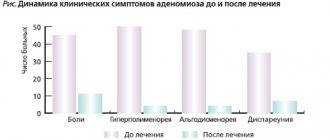Tamsulosin Tamzelin caps with prolong release 0.4 mg x30
, INSTRUCTIONS for medical use of the drug , , Tamzelin ® , Registration number LP-000620 Trade name Tamzelin ® , International nonproprietary name Tamsulosin Dosage form Extended-release capsules Composition per capsule Active substance: , tamsulosin, hydrochloride, pellets, 0, 15,%, 267,mg, containing tamsulosin hydrochloride 0.4 mg. Pellet excipients: sucrose - 143.36 mg, starch - 95.58 mg, ethylcellulose - 3.74 mg, hypromellose - 2.56 mg, povidone K-30 - 1.5 mg, copovidone (plasdon S-630) - 2.54 mg, hypromellose, phthalate, – , 10.4, mg, , cetyl, alcohol, – 1.0, mg, , diethyl phthalate, – 0.35, mg, , talc, – , , , , , . . . 5.47 mg. Gelatin capsule composition: Gelatin - 62.306465 mg Cap: Dyes: Diamond black - 0.0065 mg Blue patent - 0.00715 mg Quinoline yellow - 0.00871 mg Iron oxide yellow - 0.071175 mg Titanium dioxide - 1.3 mg Base: Dyes: Titanium dioxide - 1.3 mg
Description , Gelatin capsules No. 2 with a white body, light green lid. The contents of the capsules are white or almost white spherical pellets. Pharmacotherapeutic group Alpha1-adrenergic blocker. ATX code: G04CA02. Pharmacological properties Pharmacodynamics Tamsulosin is a specific blocker of postsynaptic α 1-adrenergic receptors located in the smooth muscles of the prostate gland, cervix, bladder, and prostatic part of the urethra. Blockade of α1-adrenergic receptors leads to a decrease in the tone of the smooth muscles of the prostate gland, bladder neck and prostatic urethra and improved urine outflow. At the same time, both the symptoms of emptying and the symptoms of filling of the bladder, caused by increased tone of smooth muscles, and detrusor hyperactivity, with benign prostatic hyperplasia, are reduced. The ability of tamsulosin to act on the α 1A subtype of adrenergic receptors is 20 times greater than its ability to interact with the α 1B subtype of adrenergic receptors, which are located in vascular smooth muscle. Due to its high selectivity, tamsulosin does not cause a clinically significant decrease in systemic blood pressure (BP), both in patients with arterial hypertension and in patients with normal blood pressure. Pharmacokinetics Absorption Tamsulosin is almost completely absorbed from the gastrointestinal tract and has almost 100% bioavailability. Absorption of tamsulosin decreases slightly after meals. The same level of absorption can be achieved if the patient takes the drug after a normal breakfast each time. Tamsulosin is characterized by linear kinetics. When taking the primary dose of tamsulosin after a meal, the maximum concentration (Cmax) of the drug in the blood plasma is achieved after 6 hours. Distribution: Bonding with blood plasma proteins - 99%, volume of distribution - 0.2 l/kg . Metabolism Tamsulosin, to a minor and slow extent, undergoes primary metabolism in the liver. Most of the drug is present in the blood unchanged. The results of in vitro studies showed that CYP3A4 isoenzymes, as well as CYP2D6, are involved in the metabolism of tamsulosin hydrochloride, with possible less significant effects from other isoenzymes. Inhibition of the drug-metabolizing enzymes CYP3A4 and CYP2D6 may result in increased exposure to tamsulosin hydrochloride. With minor and moderate degrees of liver failure, no adjustment of the drug dosage regimen is required. Excretion Tamsulosin and its metabolites are excreted mainly by the kidneys, about 9% of the dose is excreted unchanged. The half-life (T 1/2) of the drug is 10-13 hours. In case of renal failure, no reduction in the dose of the drug is required, if the patient has severe renal failure (creatinine clearance (CC) less than 10 ml/min ), tamsulosin should be prescribed with caution.
Indications for use Treatment of dysuria associated with benign prostatic hyperplasia.
Contraindications Hypersensitivity to tamsulosin or any auxiliary component of the drug. Severe liver failure. Orthostatic hypotension (including history). Children under 18 years of age.
With caution: Severe renal failure (creatinine clearance less than 10 ml/min). Arterial hypotension. Use during pregnancy and breastfeeding Tamsulosin is not indicated for use in women.
Directions for use and dosage: Orally, after breakfast. It is recommended not to chew the capsule, but to wash it down with a small amount of water. Adults over 18 years of age, as well as elderly patients: 1 capsule (0.4 mg) 1 time per day. Patients with impaired liver and kidney function: For mild to moderate renal and hepatic impairment, no dose adjustment is required. , , Side effect According to , the World , Health Organization , (WHO), undesirable , reactions are classified , in , accordance , with , their , frequency , of development , in the following , way: , very , often (≥1/10), often (≥1/100, <.1/10), infrequently (≥1/1000, <.1/100), rarely (≥1/10000, <.1/1000), very rarely (<.1/10000 ), frequency unknown - based on available data, it was not possible to determine the frequency of occurrence. From the nervous system: often: dizziness, infrequently: headache, rarely: fainting, sleep disturbance (drowsiness or insomnia). On the part of the organ of vision, the frequency is unknown: blurred vision, blurred vision. From the cardiovascular system: uncommon: postural hypotension, tachycardia, palpitations, rare: chest pain, atrial fibrillation. From the respiratory system: uncommon: rhinitis, shortness of breath, frequency unknown: nosebleeds. From the gastrointestinal tract: uncommon: constipation, diarrhea, nausea, vomiting. From the skin and subcutaneous tissue: uncommon: rash, itching, urticaria, rare: angioedema, very rare: Stevens-Johnson syndrome, frequency unknown: erythema multiforme, exfoliative dermatitis. Other: often: ejaculation disorders, including retrograde ejaculation and ejaculatory insufficiency, uncommon: asthenia, back pain, small pupil syndrome during cataract surgery, very rare: priapism, decreased libido. During post-registration observations, cases of intraoperative instability syndrome of the iris (narrow pupil syndrome) were identified during surgery for cataracts and glaucoma of the eye in patients taking tamsulosin. During post-registration observations, in addition to the adverse events described above, cases of atrial fibrillation, arrhythmia, tachycardia and dyspnea associated with the use of tamsulosin were described. ,Because ,spontaneous ,reports ,have ,been ,in ,the ,framework ,of ,post-marketing ,studies ,around ,the ,world, ,it ,is ,not ,possible ,with ,sufficient ,degree ,of ,reliability ,to ,assess ,the ,frequency ,of ,the ,development ,of ,these ,phenomena, ,and ,their ,relationships. with the use of tamsulosin.
Overdose Symptoms Overdose of tamsulosin hydrochloride can potentially lead to acute hypotensive effects. Such effects have been reported under a variety of overdose conditions. Treatment In case of overdose and development of hypotension, it is recommended to transfer the patient to a horizontal position and carry out measures aimed at maintaining the activity of the cardiovascular system (restoring blood pressure and heart rate) , gastric lavage, administration of activated carbon and osmotic laxatives, agents such as sodium, sulfate. If there is no effect, it is necessary to introduce substances that increase the volume of circulating blood and, if necessary, vasoconstrictors. Kidney function should be monitored and general supportive measures should be taken. Dialysis is unlikely to be effective because tamsulosin is highly bound to plasma proteins.
Interaction with other drugs When used simultaneously with atenolol, enalapril and nifedipine, no drug interactions were identified. When used simultaneously with cimetidine, the concentration of tamsulosin in the blood serum increases; when furosemide is prescribed, it decreases. However, no dose adjustment is required since tamsulosin concentrations remain within the therapeutic range. Diazepam, propranolol, trichlormethiazide, chlormadinone, amitriptyline, diclofenac, glibenclamide, simvastatin and warfarin do not change the level of the free fraction of tamsulosin in blood plasma in vitro. In turn, tamsulosin also does not change the content of free fractions of diazepam, propranolol, trichlormethiazide and chlormadinone. Diclofenac and warfarin may increase the elimination rate of tamsulosin. Concomitant use with strong CYP34A isoenzyme inhibitors may lead to an increase in tamsulosin concentrations. Simultaneous use with ketoconazole led to an increase in the area under the pharmacokinetic concentration-time curve (AUC) and maximum concentration (Cmax) by 2.8 and 2.2 times, respectively. Tamsulosin hydrochloride should not be used in combination with strong CYP34A inhibitors in patients with impaired metabolism of the CYP2D6 isoenzyme. The drug should be used with caution in combination with strong and moderate inhibitors of the CYP34A isoenzyme. Simultaneous administration of tamsulosin and paroxetine leads to an increase in the area under the pharmacokinetic concentration-time curve (AUC) and maximum concentration (Cmax) by 1.3 and 1.6 times, respectively. Simultaneous administration of other α1-adrenergic receptor antagonists may lead to increased hypotensive effect.
Special instructions As with the use of other α1-adrenergic blockers, during treatment with tamsulosin, in some cases, a decrease in blood pressure (BP) may be observed, which, sometimes, can lead to a fainting state. At the first signs of orthostatic hypotension (dizziness, weakness), the patient should sit or lie down and remain in this position until the signs disappear. During surgical interventions for cataracts while taking the drug, it is possible to develop a syndrome of intraoperative instability of the iris of the eye (narrow pupil syndrome), which must be taken into account by the surgeon during preoperative preparation of the patient and during operations. It is not recommended to initiate therapy with tamsulosin in patients scheduled for surgery for cataracts or glaucoma. ,During ,operative ,examination, ,before ,operating ,patients, ,the ,surgeon ,or ,ophthalmologist ,should ,consider ,whether ,the ,patient ,is ,taking ,tamsulosin. Before starting drug therapy, the patient should be examined to exclude the presence of other diseases that may cause the same symptoms as benign prostate hyperplasia. Digital, rectal, and, if necessary, prostate-specific antigen (PSA) examinations should be performed before treatment and at regular intervals thereafter. There are reports of cases of the development of prolonged erection and priapism during therapy with α1-blockers. If an erection persists for four hours, you should immediately seek medical help. If priapism therapy is not carried out immediately, this may lead to tissue damage to the penis, and irreversible loss of potency.
Impact on the ability to drive vehicles, machinery During the treatment period, it is necessary to observe caution when driving vehicles and performing potentially hazardous activities that require increased concentration and speed of psychomotor reactions.
Release form Extended release capsules 0.4 mg. 10 or 20 capsules per blister pack. 1, 3, 6 blister packs of 10 capsules or 3, 5 blister packs of 20 capsules with instructions for use are placed in a cardboard pack. 60, 100 capsules in polymer jars. Each jar with instructions for use is placed in a cardboard pack.
Storage conditions In a place protected from light at a temperature not exceeding 30 ℃. Keep out of the reach of children.
Shelf life: 3 years. Do not use after the expiration date.
Conditions of release Dispensed by prescription.
Tamzelin 30 capsules extended release 0.4 mg
Registration Certificate Holder
WELFARM (Russia)
Dosage form
Medicine - Tamzelin® (Tamzelin®)
Description
Long-acting capsules
1 tablet.
tamsulosin hydrochloride 400 mcg
10 pieces. — cellular contour packages (1) — cardboard packs. 10 pieces. — cellular contour packages (3) — cardboard packs.
Indications
Treatment of dysuric disorders in benign prostatic hyperplasia.
Contraindications for use
Hypersensitivity to tamsulosin; orthostatic hypotension (including a history), severe liver failure; children and adolescents up to 18 years of age.
Carefully:
severe renal failure (creatinine clearance less than 10 ml/min); arterial hypotension.
pharmachologic effect
α1-adrenergic receptor blocker; a drug for the symptomatic treatment of benign prostatic hyperplasia.
Selectively blocks postsynaptic α1A-adrenergic receptors of smooth muscles of the prostate gland, bladder neck, prostatic urethra. As a result, the tone of the smooth muscles of these formations decreases, and the outflow of urine is facilitated. At the same time, the symptoms of obstruction and irritation associated with benign prostatic hyperplasia are reduced. The therapeutic effect appears approximately 2 weeks from the start of treatment.
Tamsulosin's ability to block α1B-adrenergic receptors of vascular smooth muscles is much less pronounced, so the effect on systemic blood pressure is insignificant.
Drug interactions
With simultaneous use of tamsulosin with cimetidine, a slight increase in the concentration of tamsulosin in the blood plasma was noted, and with furosemide - a decrease in concentration; with other α1-blockers - a pronounced increase in the hypotensive effect is possible.
Diclofenac and indirect anticoagulants slightly increase the rate of elimination of tamsulosin.
Diazepam, propranolol, trichlormethiazide, chlormadinone, amitriptyline, diclofenac, glibenclamide, simvastatin and warfarin do not change the free fraction of tamsulosin in human plasma in vitro. In turn, tamsulosin also does not change the free fractions of diazepam, propranolol, trichlormethiazide and chlormadinone.
In vitro studies showed no interaction at the level of hepatic metabolism with amitriptyline, salbutamol, glibenclamide and finasteride.
Other α1-blockers, acetylcholinesterase inhibitors, alprostadil, anesthetics, diuretics, levodopa, antidepressants, beta-blockers, slow calcium channel blockers, muscle relaxants, nitrates and ethanol may increase the severity of the hypotensive effect.
Co-administration of tamsulosin with potent inhibitors of the CYP3A4 isoenzyme may lead to an increase in tamsulosin concentrations. Co-administration with ketoconazole resulted in an increase in the AUC and Cmax of tamsulosin by 2.8 and 2.2 times, respectively.
Tamsulosin should not be used in combination with strong CYP3A4 inhibitors in patients with impaired metabolism of the CYP2D6 isoenzyme. Tamsulosin should be used with caution in combination with strong and moderate CYP3A4 inhibitors.
Dosage regimen
Inside. The recommended dose is 400 mcg 1 time / day (at the same time).
Side effect
From the cardiovascular system:
palpitations, atrial fibrillation, arrhythmia, tachycardia, shortness of breath, orthostatic hypotension.
From the side of the central nervous system:
headache, dizziness, fainting.
From the digestive system:
constipation, diarrhea, nausea, vomiting.
For the skin and subcutaneous tissues:
skin rash, itching, urticaria, angioedema, Stevens-Johnson syndrome, erythema multiforme, exfoliative dermatitis.
From the reproductive system:
ejaculation disorders, priapism.
Other:
rhinitis, asthenia. Cases of intraoperative instability of the iris (narrow pupil syndrome) have been described during surgery for cataracts and glaucoma in patients taking tamsulosin.
special instructions
Before starting tamsulosin therapy, the patient should be assessed for other diseases that may cause the same symptoms as benign prostatic hyperplasia. Before starting treatment and regularly during therapy, a digital rectal examination and, if required, determination of prostate specific antigen should be performed. In patients with impaired renal function, no change in dosage regimen is required.
There are reports of cases of the development of prolonged erection and priapism during therapy with α1-blockers. If an erection persists for more than 4 hours, you should immediately seek medical help. If priapism therapy is not carried out immediately, it can lead to damage to the tissue of the penis and irreversible loss of potency.
Some patients taking or previously taking tamsulosin may develop intraoperative iris instability syndrome (narrow pupil syndrome) during surgery for cataracts or glaucoma, which can lead to complications during surgery or in the postoperative period.
It is not recommended to initiate tamsulosin therapy in patients scheduled for cataract or glaucoma surgery. During the preoperative examination of patients, the surgeon and ophthalmologist should consider whether the patient is taking or has taken tamsulosin. This is necessary to prepare for the possibility of developing intraoperative iris instability syndrome during surgery. Effect on the ability to drive vehicles and machinery
During the period of use of tamsulosin, patients should be careful when driving vehicles and machinery, as well as when engaging in other potentially hazardous activities that require increased concentration and speed of psychomotor reactions.
Use during pregnancy and breastfeeding
Restrictions during pregnancy - Contraindicated. Restrictions when breastfeeding - Contraindicated.
Not applicable.
Use for renal impairment
Restrictions in case of impaired renal function - Use with caution. Use with caution in severe renal failure (creatinine clearance < 10 ml/min).
Use for liver dysfunction
Restrictions for liver dysfunction - With caution. Contraindicated for use in severe liver failure.
Use in children
Restrictions for children - Contraindicated. Use in children and adolescents under 18 years of age is contraindicated.




